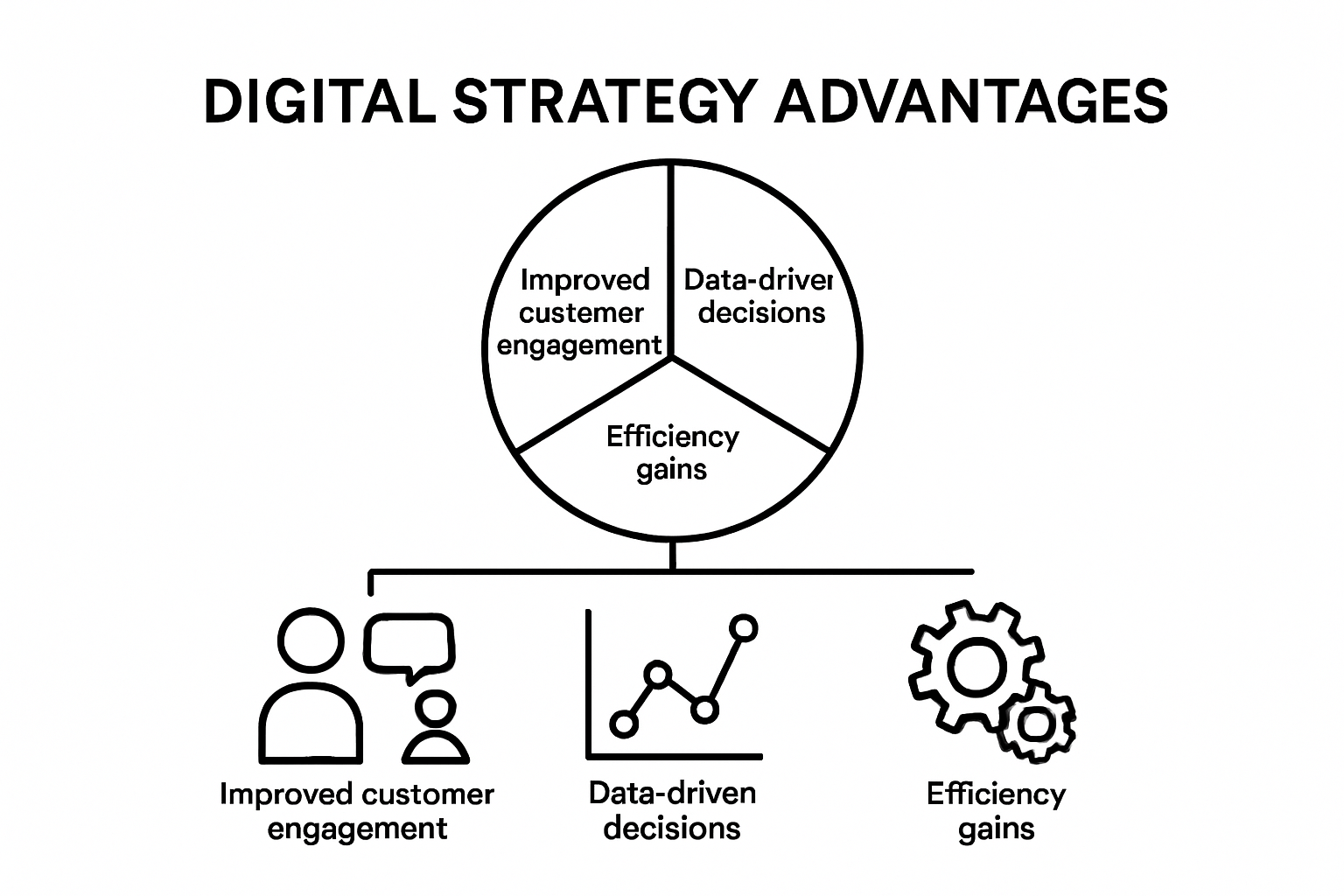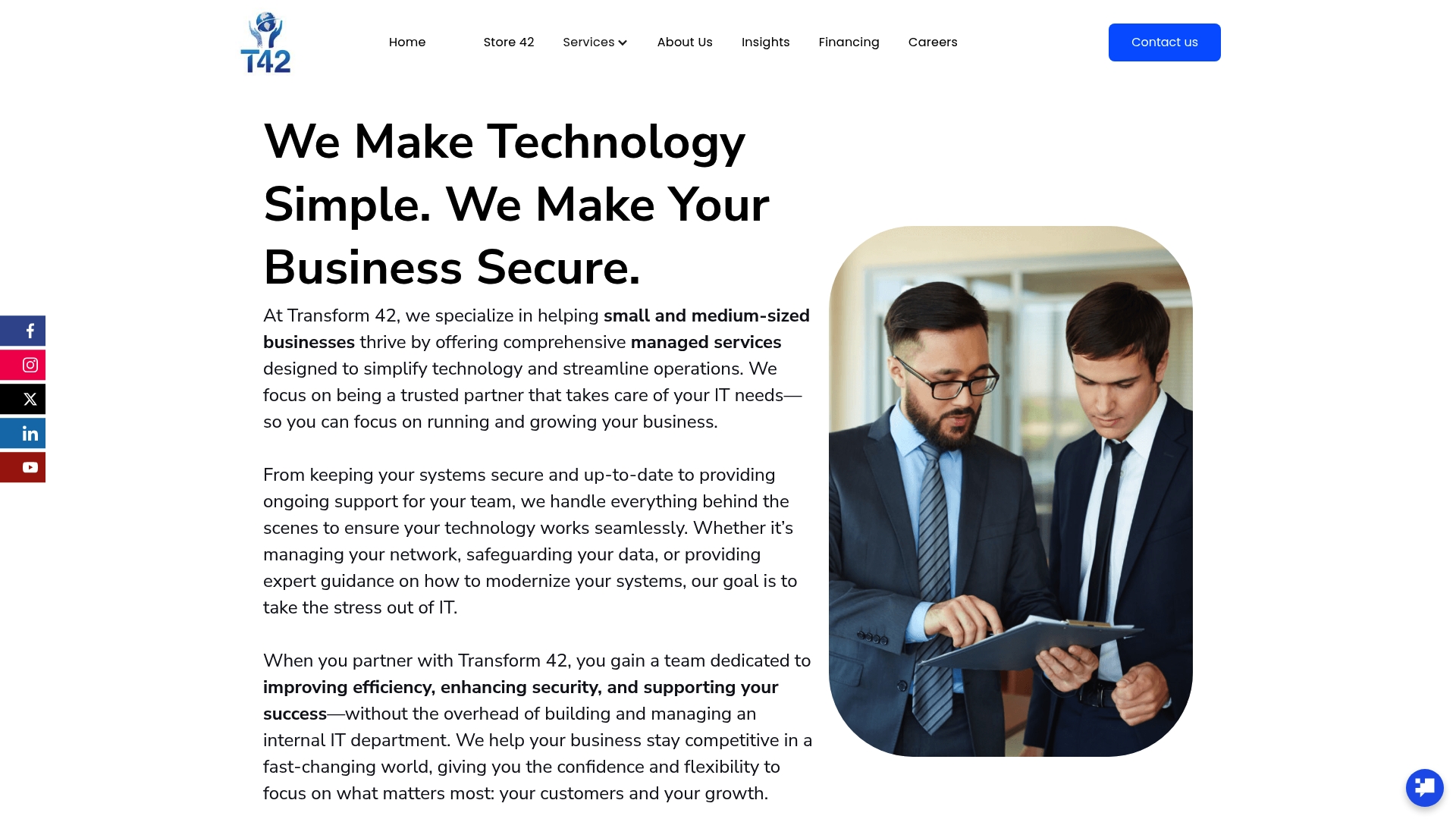
Digital strategy sounds like a buzzword every company throws around these days and yet few know what it really means for their future. Surprise, because organizations with integrated digital strategies are 2.5 times more likely to see substantial performance improvements than those without a plan backing their technology. Most people assume digital strategy is just about using the latest tools but the real power comes when every piece of tech and data works together towards a bigger vision that drives growth and resilience.
TakeawayExplanationDigital strategy is essential for successOrganizations must integrate digital technology to remain competitive in today’s economy. Without it, they risk obsolescence.Align technology with business goalsSuccessful digital strategies require a holistic approach, connecting tech capabilities directly to overarching business objectives.Invest in continuous learningOngoing employee training and culture adaptation are critical for navigating digital transformation effectively and achieving sustainable growth.Utilize data for decision-makingImplementing data analytics improves decision-making and enhances customer engagement and operational efficiency, driving overall business success.Emphasize customer experience designPrioritizing seamless digital interactions leads to better customer satisfaction and loyalty, which are vital for long-term business performance.
A digital strategy represents a comprehensive plan that outlines how an organization will leverage digital technologies, platforms, and capabilities to achieve specific business objectives. Unlike traditional marketing approaches, digital strategy integrates technology, data, and strategic planning to create a holistic approach to organizational growth and competitive positioning.
To clarify the essential elements that form a comprehensive digital strategy, the table below outlines the core components and their specific roles within an organization.
Core ComponentDescriptionTechnology InfrastructureFoundational systems and tools supporting business operationsData AnalyticsMechanisms for collecting, analyzing, and interpreting digital performance metricsCustomer Experience DesignApproaches for creating seamless digital interactions and touchpointsDigital Marketing AlignmentIntegration of digital channels with broader marketing and communication objectives
Digital strategy encompasses several critical elements that work together to drive organizational transformation and digital effectiveness. These components include:
Successful digital strategy requires a systematic approach that goes beyond simple technological adoption. Organizations must develop a comprehensive framework that includes:
According to McKinsey & Company, organizations that develop integrated digital strategies are 2.5 times more likely to achieve significant performance improvements compared to their less strategic counterparts.
Implementing an effective digital strategy is not about implementing random technological solutions but creating a purposeful, aligned approach that connects technological capabilities with core business strategies. This requires ongoing commitment, investment in talent, and a willingness to continuously learn and adapt in an increasingly complex digital landscape.
In the rapidly evolving global business landscape, digital strategy has transformed from a competitive advantage to an absolute necessity for organizational survival. Companies that fail to recognize and adapt to digital transformation risk becoming obsolete in an increasingly technology-driven marketplace.
Digital strategy serves as a critical mechanism for economic resilience and growth. Businesses that effectively implement comprehensive digital approaches can unlock new revenue streams, optimize operational efficiency, and create more responsive organizational structures. The digital economy demands agility, with organizations needing to quickly pivot and adapt to changing technological and market conditions.
The following table summarizes the strategic competitive advantages organizations may realize by adopting robust digital strategies, making it easier to compare and understand their benefits.
Competitive AdvantageBusiness ImpactImproved Customer EngagementEnables personalized experiences and deeper relationshipsData-Driven Decision MakingEnhances accuracy and speed of business decisionsIncreased Operational EfficiencyReduces costs and streamlines internal processesFaster Innovation CyclesAccelerates product development and go-to-marketMarket ResponsivenessAllows quicker adaptation to market and technology changes
Organizations with robust digital strategies gain significant competitive advantages through:

Digital strategy is no longer optional but a fundamental requirement for economic participation. According to the OECD Digital Economy Outlook, nations and businesses that prioritize digital transformation are better positioned to drive economic growth, create new employment opportunities, and maintain global competitiveness.
The economic landscape is fundamentally shifting, with digital technologies becoming the primary drivers of value creation. Companies that view digital strategy as a strategic imperative rather than a tactical afterthought will be best equipped to navigate the complex, interconnected global economy of the 21st century.
This transformation requires more than technological investment. It demands a holistic approach that integrates digital capabilities with organizational culture, strategic vision, and continuous learning. Successful digital strategies recognize that technology is not just a tool, but a fundamental way of thinking about business, innovation, and value creation.
Digital strategy transforms businesses by creating systematic approaches that leverage technology to drive growth, efficiency, and competitive advantage. Instead of viewing digital tools as isolated solutions, successful organizations integrate digital capabilities into their core business model, fundamentally reshaping how they operate and deliver value.
Effective digital strategies directly impact business performance by streamlining operations, reducing costs, and creating new revenue opportunities. Organizations that implement comprehensive digital approaches can significantly improve their productivity and operational agility. Digital transformation enables businesses to respond faster to market changes, automate complex processes, and make more informed decisions through data-driven insights.
Businesses can drive success through digital strategy by focusing on key value creation mechanisms:
According to McKinsey, companies with robust digital strategies are three times more likely to report significant revenue growth compared to industry peers. This competitive advantage stems from the ability to:
Successful digital strategy is not about implementing the most advanced technologies, but about creating an adaptive organizational approach that integrates digital capabilities with strategic vision. This requires continuous learning, cultural transformation, and a willingness to experiment and evolve. Businesses that view digital strategy as a dynamic, ongoing process rather than a one-time implementation are most likely to achieve sustainable competitive advantages in an increasingly digital global economy.
Digital strategy frameworks provide structured approaches for organizations to systematically navigate technological transformation. These conceptual models help businesses understand how to integrate digital technologies, align technological capabilities with strategic objectives, and create sustainable competitive advantages.
Successful digital strategy frameworks emphasize the critical importance of organizational alignment. This means creating a comprehensive approach that connects technological capabilities with broader business goals, ensuring that digital initiatives are not isolated technological experiments but integrated components of overall organizational strategy.
Effective digital strategy frameworks typically incorporate several fundamental elements:
According to OECD’s Digital Government Framework, successful digital strategy implementation requires:
Digital strategy frameworks are not static documents but living strategies that evolve with technological advancements and organizational needs. They represent a holistic approach to digital transformation, recognizing that technological change is fundamentally about reimagining how organizations create value, engage with stakeholders, and respond to emerging market opportunities.

The most effective frameworks move beyond technical implementation, focusing on cultural transformation, workforce development, and creating adaptive organizational capabilities that can continuously learn and innovate in a rapidly changing digital landscape.
Real-world digital strategy examples demonstrate how organizations across various industries can transform their business models, enhance customer experiences, and drive significant competitive advantages through strategic technological implementation.
Some organizations have fundamentally reimagined their business models through innovative digital strategies. These transformations go beyond simple technological adoption, representing comprehensive approaches that integrate digital capabilities into core business operations and strategic thinking.
Different industries showcase unique approaches to digital strategy implementation:
According to Emeritus Institute, Domino’s Pizza represents a remarkable digital strategy success story. The company transformed from a traditional pizza restaurant to a technology-first organization by:
Successful digital strategies share common characteristics: they are holistic, customer-centric, and designed to create tangible business value. These approaches recognize that digital transformation is not about implementing isolated technological solutions, but about fundamentally reimagining how organizations create, deliver, and capture value in an increasingly digital world.
The most effective digital strategies demonstrate that technological innovation is not just a technical challenge, but a comprehensive organizational transformation that requires strategic vision, cultural adaptation, and continuous learning.
Does your business struggle to translate digital strategy frameworks into measurable growth? Many companies know they need to transform but find it hard to connect technology investments with real performance improvements. This article shows how integrated digital strategies can unlock agility, innovation, and customer value. But without expert guidance, the path can seem complex and overwhelming.

At Transform 42 Inc., our team helps small and medium-sized businesses bridge this gap. We specialize in digital transformation consulting that gets real results. We align technology, data, and your operations so you can boost efficiency, improve decision making, and deliver better customer experiences. Let us help you move beyond theory into action. Visit Transform 42 Inc. today to schedule a free digital maturity assessment. Your future-ready business starts now.
A digital strategy is a comprehensive plan that outlines how an organization uses digital technologies and platforms to achieve specific business objectives, integrating technology, data, and strategic planning for effective organizational growth.
Digital strategy is crucial for businesses as it enables them to respond to the rapidly changing market landscape, enhances operational efficiency, creates competitive advantages, and fosters innovation, ultimately driving economic resilience and growth.
Key components of a successful digital strategy include technology infrastructure, data analytics, customer experience design, and alignment with digital marketing initiatives, all working together to support business objectives.
Businesses can implement a digital strategy effectively by assessing current digital capabilities, defining clear business goals, continuously evaluating digital initiatives, investing in employee skills, and fostering a culture of adaptation and learning.